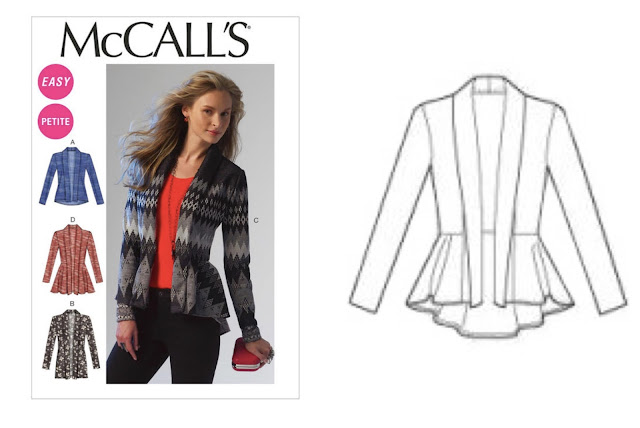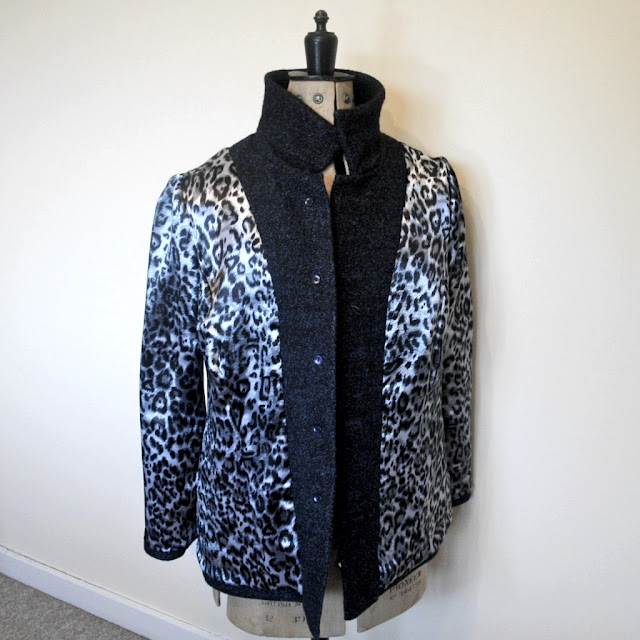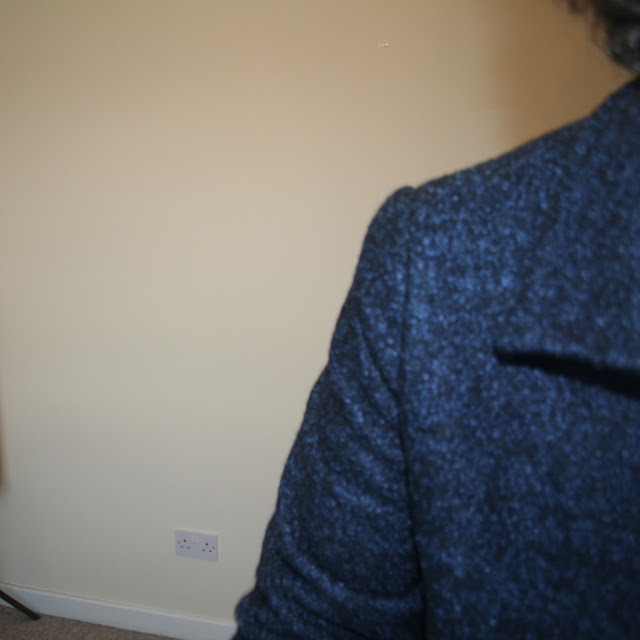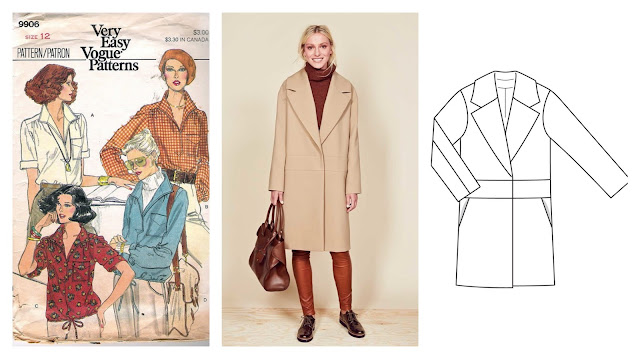My second post for this end of the year review is about what I made, how it worked out for me, and how my wardrobe overall has turned out this year. For the purposes of this post, I've put the bit I think most people are interested in (my sewing and various top 3s) at the start, and my long-winded wardrobe analysis at the end where it's most easily skipped by people who dislike that sort of thing.
Numbers: Patterns and pattern sources
I sewed 36 garments this year, plus 3 wadders that I discarded without finishing. Including the wadders, I used 29 different patterns, of which 18 were new to me and the remainder were repeats.
My patterns were split between:
Magazines: 15 patterns (8 Burda, 4 Ottobre, 2 Knipmode, 1 Other)
Big 4 Envelopes: 9 patterns (including 4 Burda envelopes)
Indies/PDFs: 4 patterns (including 2 StyleArc)
No pattern: 1 (gathered waist maxi skirt i.e. a giant rectangle with elastic at the top)
This is a very typical pattern source mix for me -- plenty of Burda, a sprinkling of Big 4 and Indies.
Of the three wadders that I discarded unfinished, two were down to poor fabric choice (a Burda knit top pattern that needed a much drapier knit and a Grainline Linden sweater in a fabric so horrible that I don't know why I ever cut into it), and one was due to not liking the shape or style of the pattern on my body (a Burda ponte knit jacket, about which more below).
I also finished two hand-knitted jumpers this year, one of which was flawed and the other a wadder. I do not have what you might call a stunning knitting success rate, and I have to admit my enthusiasm for knitting has waned considerably this year.
Challenges: Magazine and Wishlist Challenges 2017
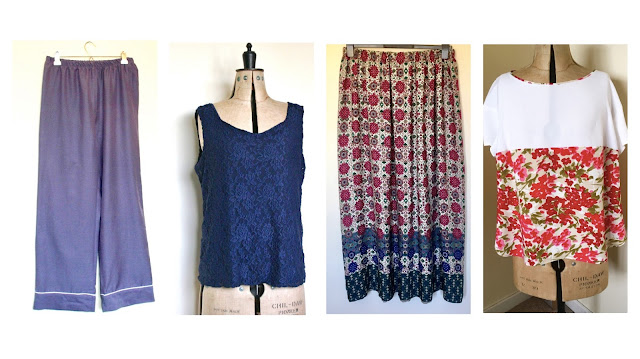 |
| Wishlist Challenge garments: indulgent silk PJs (Burda 01-2017-124), two layer knit stretch lace top (Diana Moden), border print maxi skirt (no pattern) and refashioning a top made in 2013 with this printed viscose fabric (Burda 05-2015-124) |
This year my only specific goals for my actual sewing were that I planned to do two challenges: a Magazine challenge, using one pattern a month from any 2017 magazine issue; and a Wishlist challenge, making one thing each month off my long-established wishlist of things I really wanted to sew, many of which are more challenging/complex.
 |
Magazine Challenge items (Burda 01-2017-119 Draped front knit top,  Burda 03-2017-126A striped top, Burda 03-2017-126A striped top,  Knipmode 07-2017-11 (Men’s) Tee (as pyjamas) and Knipmode 07-2017-11 (Men’s) Tee (as pyjamas) and  Knipmode 01-2017-13 purple tunic) Knipmode 01-2017-13 purple tunic) |
Sadly, the whole challenge idea was kind of a damp squib this year, mainly because I was so ill for so much of the year. Even when I could sew, I often wasn't up for sewing anything challenging, or really even for the effort of doing a lot of pattern tracing from magazines. That said, I did manage to use four patterns from 2017 magazine issues successfully, (plus one wadder); and I made four things that were on my wishlist. As you'll see below, several of the things I chose to make for the Magazine challenges were my favourite things I made all year, so in that sense, I regard that as a success. I don't think the Wishlist Challenge worked overall at all, and I shan't bother to do it again. That said, one thing I do love is my silk/cotton "indulgent" pyjamas, so they were definitely a worthwhile thing to make that I might not have done without the Wishlist Challenge to inspire me.
What I Made
You can see everything I made in 2017 on my
Completed Projects: 2017 page. The only things missing are the handful of projects that I am still working on this month or haven't taken photos of yet -- they're in my numbers, just not on my blog yet!
Overall, as has probably been made abundantly clear already, this was a really difficult year for me health-wise and the things I sewed reflect that. In fact, if you look at my sewing chronologically this year, you can pretty much chart how ill I was at any given time. In the short periods where I felt genuinely well, I actually made some interesting, challenging things. The rest of the time I either didn't sew at all, or I made easy knit items, mostly using patterns I've made several times before, and of course my perpetual I-want-to-sew-but-I-feel-grotty standby: pyjamas. I made a LOT of pyjamas this year. My pyjama drawer is over-flowing.
Anyway, some things worth highlighting (or lowlighting, I guess, in some cases):
OVERALL TOP THREE:
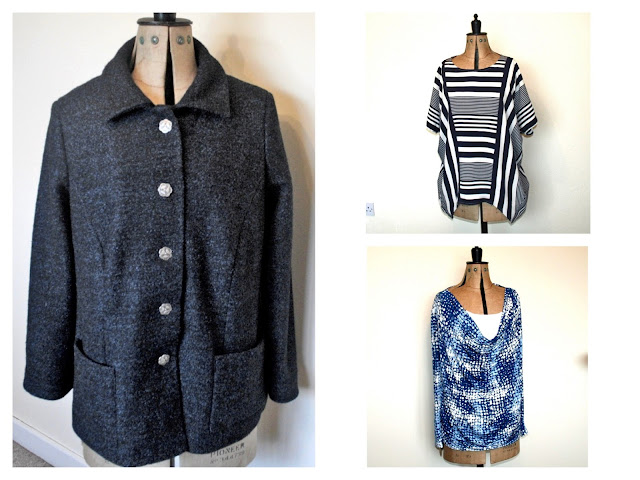 |
| Top 3: Burda 6461 Jacket (left), Burda 03-2017-126A (top right), Burda 01-2017-119 (bottom right) |
These are the three things that I think are just overall the best things I made this year: best fabrics, best sewing, best pattern choices. There should be no surprises here at all that my number 1, best thing I made this year is the
boiled wool jacket I finished this month. Nothing about wearing it over the last couple of weeks has changed my mind about it: I love it, it fits really well and it looks great on. Overall: A+, still patting myself on the back so hard I'm going to sprain my wrist.
My other two favourite projects this year are two tops, both of which I made as part of the Magazine Challenge
in January (the draped knit top on the bottom right) and
February (striped top on the top right) respectively. The striped one in particular, made with Burda 03-2017-126A, is a real eye-catcher of a top. I get so many compliments on it when I wear it, and it's really different and interesting without necessarily being trendy, so I think it will have decent longevity. Definitely worth the extreme amount of time it took me to cut it out to get all my stripes perfect! The knit top, Burda 01-2017-119, is less spectacular, but it's got such a great drape to it, and I used really nice fabric, so it's also a big favourite.
FLAWED FAVOURITES
 |
| Knipmode 01-2017-13 tunic (left); Tapestry Tote (upper right); Lichen jumper (bottom right) |
These three are the things I love, but that definitely have flaws. The Knipmode tunic is a favourite that I've worn a LOT since
I made it in November, but the zip insertion/neckline is definitely not my best work. Or even remotely LIKE my best work, if I'm honest. It doesn't really affect how much I wear and love it though. I really like
the tapestry/faux suede overnight bag that I made (upper right), but I wish I had done a better job with putting the leather handles on. As for t
he Lichen jumper, I was originally more than a bit dubious about it, but I came to love it, and again I get a lot of compliments on it. The major flaw is that it's made of a linen blend yarn that grows so badly in wear that it starts off around hip length and ends up a mini dress by the end of the day.
MISSES
 |
| Il Grande Favorito jumper (left); Burda jacket 08-2016-134 (top right); Burda top 05-2015-125 (bottom right) |
My three misses have one thing in comment: they all took a lot of time or effort or both and the outcome was subpar. The jumper on the left, knitted with the Il Grande Favorito pattern, is the most obvious example of time/effort not equaling the reward!
I finished it in January and by that time it had taken approximately forever to knit it, and it was actually... not great, but it was OK. And then I washed it and it shrank about 4 sizes and was a total disaster, and I didn't even wear it once.
The wadder jacket, Burda 08-2016-134, on the upper right, I spent a long time sewing it as far as I got, and I am still really proud of how well the cut-on top-stitched collar came out, but it fit very poorly and I hated the shape of it, so
I discarded it unfinished. I am very sad for the loss of that fabric still!
And finally, that Burda 05-2015-125 viscose top on the bottom left was something I thought about for a really long time. I ended up wrecking the first attempt at making something with this remnant, and then although I was positive about it
in my post on the topic, making this and seeing the result is what really put me off making any more wovens until I could start to address my neckline/shoulder fitting problems. It is the only one of the three that actually made it into my wardrobe and I have worn it a couple of times, but eh, I don't think it's going to get a huge amount of wear.
While I was writing this post I kept going back to my page of the things I made this year and thinking:
but these other things were all also really great! But they're really boring! But they're also really great, and I wore them SO MUCH, how can they not be in a top 3? But they're really too boring to be in a top 3! And so on. So, I guess I want to say that even though very little of my other sewing this year was in any way remarkable, it mostly worked out really well! I made things, including all those many many pairs of PJs, and multiple StyleArc Estelle cardigans, and various simple t-shirt-y type things, that I've worn a lot and that I really like enormously. My sewing output overall was really not at all exciting, but I
still feel like it was a really successful sewing year.
Wardrobe analysis
Acquisitions
This year, I
acquired a lot of clothes (104 garments) and discarded fewer (66
garments in total), so my wardrobe grew overall after a couple of years
of decreases in size. That was a big year for me, in terms of new
acquisitions -- essentially two new things a week! In previous years
I've acquired more like 60-70 items. However, although substantial, this
increase was also largely intentional as I deliberately expanded my
wardrobe in particular areas. I didn't entirely get this increase right,
inasmuch as there were things I bought/made that I ended up wearing
less than I expected, but that's fine: none of the extras are things
that I don't
want to wear, they just didn't get their turn as often as other garments this year.
Of
the acquisitions, as I've described, only about one third (36 garments) were hand-made
rather than RTW. This explains why, as I said in my previous review
post, more of my money went into my RTW clothing/shoes/etc budget than
into my sewing budget over the course of the year. The relatively high
proportion of RTW isn't entirely what I want for my wardrobe, but:
1. I was sick for long stretches of the year and so some sewing plans got set aside in favour of the ease of buying RTW.
2.
I needed to replace/add quite a lot of things in categories of garments
that I don't currently make anyway, like jeans and other trousers,
certain types of t-shirts/knits, knitwear and active/gym wear.
Living With My Wardrobe
One thing that I don't think comes over at all well in this blog is how hard I've been trying to actually build a
wardrobe rather than just making/buying random clothes -- that is, a set of clothes that mix and match and work together easily. This is because (a) you only see the new things I sew, in a rather piece-meal way; (b) you obviously don't see my RTW wardrobe; and (c) I am not the kind of person who "styles" their photos of the things they've made and shows how some new thing I've made goes with one or more existing garment in outfits. So I guess it probably looks like I just make a scattershot mess of things.
I'm going to be doing things a bit differently next year so hopefully that impression will fade. However, in the meantime what I know, because I record it and can check, is that this year I
did have a pretty successful mix and match wardrobe! I definitely have favourite ways to wear some garments, but I don't own anything that can only be worn one way, which was a problem I used to have a lot.
Another thing
that is totally in the past now is opening my wardrobe and feeling like I
hate everything and don't have anything to wear. In fact, I think this actually
might be the first time in my life where I've stood in front of my
wardrobe in a morning and thought "I want to wear this! Or, no, maybe
this? Or this!" and had to choose between many favourites. I had plenty
of choice
of things that I liked in pretty much every circumstance I encountered
in my (admittedly rather circumscribed) life in 2017, which is
definitely more than I can say about many previous years. Of course, I could have
achieved this without sewing, I am sure, but sewing has been the impetus
for all my work on my wardrobe, so I'm grateful for that. I do feel like my ideas about what I want to wear and the wardrobe I want to own is really starting to coalesce, and I'm going to post something early in the New Year that explains what I want to do next on this front.
Discards and 30 Wears
I think that looking at discards as well as what I actually wear is also really revealing about how things are working out in my wardrobe. On a simple examination, a big pleasing change was that of the 66 things I discarded this year, about two thirds (45 of 66) I threw away because I judged them to be worn out -- that is, that they looked worn and in poor condition. This seems like a big improvement on previous years, where I shed a lot of things that I just never wore, that didn't fit, and so on. Nothing tells me my sewing/purchasing/wardrobe planning is working out well for me better than loving my clothes to death.
One concern I have though is how
much wear I get from the things I make and buy. That is, it sounds good to say that I've worn my clothes to the point where they aren't wearable, but not so much if that turns out to mean that I wore something 5 times and then it disintegrated in the wash. This ties in neatly something I first read about at the beginning of this year: the
30 Wears Challenge, originally proposed as a kind of shortcut to more sustainable buying practices by Livia Firth. The upshot of the
"challenge" is that you should aim to acquire only things that you think you
can wear at least 30 times. This has an impact on your choices in terms of both the versatility and
longevity/quality of garments: not only should you be asking if yourself "do I really see myself wearing this 30 times?" but also "will this last through 30 wears?".
The figure of 30 is of course just an arbitrary number, not an iron-clad rule, but it's an interesting benchmark that I wanted to investigate.
As I've been
collecting data on what I wear every day since 2015, I've increasingly got quite a lot of complete information about the garments I own. By this I mean that I
actually
know exactly how many times I have worn most of my active wardrobe and a good percentage of the things I discarded. There is zero guess work involved.
Of my 66 discards in 2017, therefore, I know that 31 of them in total have been worn 30 or more times each, some of them substantially more. All of those garments were discarded because they were no longer in wearable condition. That seems like a relatively encouraging percentage (47%) of the total to start with.
The next group of 19 discards are those I know for sure were worn more than 10 but less than 30 times each. They are noticeably mostly knits (14 of 19), both RTW and hand-made. Most of them (12 of 19) were discarded because the fabric had deteriorated badly after their 10-29 wears and I judged them no longer wearable. The rest either acquired marks or stains or were damaged in some way that I couldn't fix or didn't think was worth fixing. I tend to think there are always
going to be things in my discard pile that for one reason or another get worn a moderate amount but don't reach the 30 wears mark. However, from this alone, it seems like improving the quality of some of the knit garments and fabrics I purchase would be an obvious way to increase the overall longevity of my wardrobe.
The last group of 16 are the most troublesome. They are garments that I wore less than 10 times in total. Most of these (13 of 16) fall into a category probably best described as "never should have been in my wardrobe to start with": RTW clothes I should have returned rather than keeping, "walking wadders" that I knew from the outset I wasn't really going to be willing to wear after I made them for one reason or another. The remaining 3 were all laundry disasters -- one got put in the wrong load of laundry and came out the other end a weird colour, and the other two shrank. Again, it's likely that there are always going to be a few mistakes and laundry disasters, but I think there could be definitely be fewer "never should have been there" outcomes with a bit of effort.
This prompted me to look bit harder at the wear statistics of my active wardrobe, this year's discards and previous years' discards. As a result, I also reached these two more detailed conclusions (I'll spare you the underlying numerical analysis though!):
1. As this year's discards seemed to suggest, the quality of my knit fabric and knit garment purchases is a problem. One conclusion I've reached, quite sadly, is that buying good quality basic t-shirts when I can get them at sale prices is a better use of my money than sewing my own. This
is really quite frustrating: the cost to me is about the same but the RTW t-shirts last a great deal
longer and definitely look better over their lifetime. I've managed to find some
RTW tees that are about 90% as well-fitting as the t-shirts I sew
myself, and so long as the length isn't the 10% mis-fit (I hate
too-short t-shirts!) I can live with that level of difference. However, although I am willing to concede on the basic tee side of things, since they're unexciting to sew anyway, I really do want to make other kinds of knit tops. I therefore either need to source better quality knit fabrics or else learn to live with short lifespans in my knit garments. Something to investigate further in 2018, I think!
 |
| Alas, this woven top from 2016 did not last. It looks pretty good in these photos, but the collar shredded in the wash. |
2. Woven tops are a real problem, longevity wise. This wasn't too obvious in a single year of discards, but when I looked across the last several years, it really stands out. I am very intolerant
of fit problems with woven tops, so they form a disproportionately large number of those "walking wadder/never should have made it into my wardrobe" outcomes. I also
have more laundry problems with woven tops, which is actually easier to
solve if annoying: basically, if I want my woven tops to have decent
longevity, I need to stop tumble-drying them. Too many of the things
I've both bought and made have shrunk in the dryer and become unwearable
(even though, yes, I do pre-shrink all my fabric. Apparently just not enough!). Of woven tops that make it into the 10-29 wears group, I have more failures due to poor construction than
in any other category, like the black and white viscose top in the
photo above, which suddenly shredded all along the top collar seam
during the 12th wash. Fabric choice is also again potentially problematic.
Some of the viscose prints I've used, including that same black shirt,
lost the surface texture and colour very quickly and looked in poor
condition as a result after relatively few washes. It's again a case of find better fabric or live with short life spans.
Very few of the woven tops I've either made or bought in
the last few years have achieved anything like 30 wears. There are a few
exceptions, including
the chambray shirt that I made back in 2014
(above left), which I have worn 40+ times so far and which is still in
my wardrobe. There are definitely common features between all the higher wear
woven tops in my wardrobe: they are all made in high quality cotton
fabric; I took extra care to get a good fit; and for those I made myself I spent extra time
making sure they were sewn well with good seam finishes. So, that's a
pretty clear set of guidance for how to improve that part of my
wardrobe, especially when I have so many woven tops in my wish list for
2018.
In conclusion: these kind of arbitrary wardrobe rules (30 Wears, Project 333, whatever) are always a bit suspect to me. However, I do think there's some validity to the 30 Wears idea. Of course, I'm not going to stop wearing something because it's hit 30 wears if it still has plenty of life in it -- and for sure I expect some things, like coats or hard-wearing garments like jeans, to last considerably more than 30 wears. On the other hand, I'm also not going to keep wearing things that are falling apart or that are uncomfortable for some reason because I've not managed to wear it 30 times yet. However, I think it's a nice benchmark to look at and I feel like examining my discards against it actually gave me quite a lot of information and ideas about where I could improve my sewing and wardrobe plans in the future.
My next post in this series, which I will publish on 1 January, is about my plans for 2018, and I'm going to try to fold a lot of the things I've talked about here, and that I've learned from my discard pile, into how I plan to approach what I sew next year and how I sew it.
